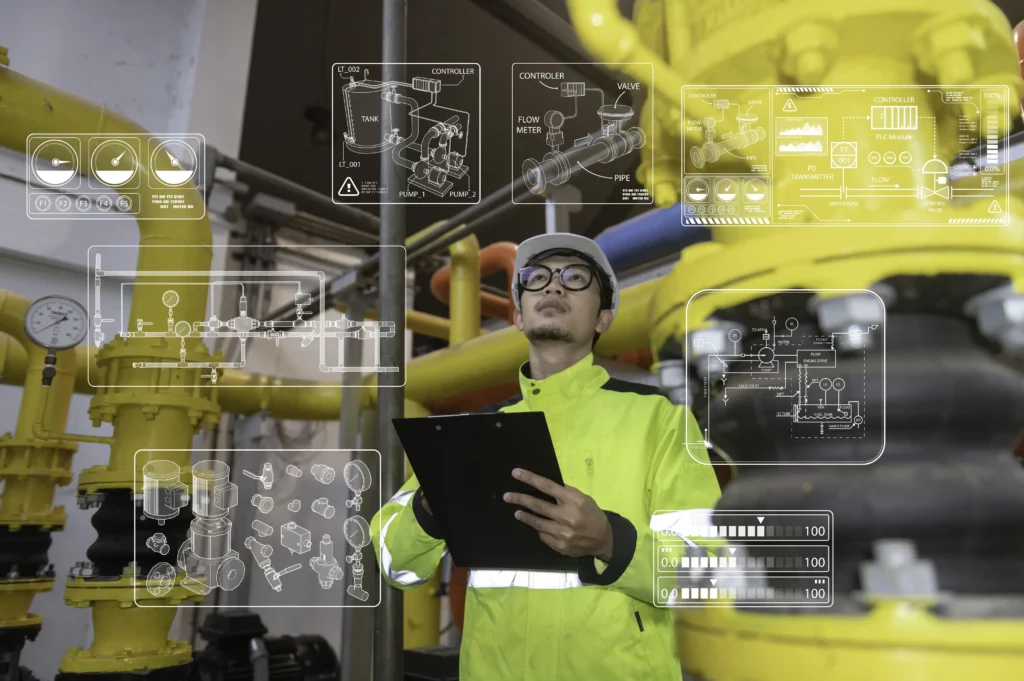Author: Ing. Mayuly Rodríguez, November 30, 2023.
Introduction
Industrial inspections are a fundamental part of facility maintenance and safety. Inspectors must collect a large amount of data during inspections, including condition, performance and safety reviews. This process is important for several reasons; allows inspectors to access asset history quickly and easily, to perform analysis and identify trends and patterns that may reveal problems; Likewise, it allows interested parties to share information with other team members.
In the era of digitization and data storage, industrial inspections have evolved positively. The ability to collect, store and analyze large volumes has transformed these activities, providing deep insight into industrial assets and even entire systems. This article addresses how data warehousing has improved industrial inspections, highlighting features, benefits, key technologies and applications of this process.
Data storage
It refers to the process of storing digital information permanently or semi-permanently. The data can be of any type, including text, images, audio and video. There is a variety of technologies available, which include physical hardware such as hard drives, solid state drives, flash memories and optical systems to virtual solutions such as databases and cloud storage, which today are the most relevant for allow the user to store information on remote servers.
The choice of technology type depends on a series of factors, such as data type, size, required performance and available budget. This process is a main part of modern technology; because it allows you to save and access information when needed. Additionally, a well-structured storage system facilitates collaboration between different departments and stakeholders, ensuring that everyone involved is informed and coordinated.
Data in industrial inspections
During industrial inspections, large amounts of data on the assets evaluated are managed; This includes inspection and maintenance history, corrosion controls, and even engineering and design information that is relevant to understanding and analyzing the traceability of assets during their operational function.

Each review collected is a clue about the asset; from defect images, change in operational variables, ultrasound thickness measurements to weld maps, contribute to a comprehensive understanding of the element.
In the investigative field of inspections it often requires collecting a considerable amount of information, comparisons and future analysis. Historically, there were physical limitations, such as lack of storage space or low transfer speeds. With technological advances, compact and economical formats have been generated, which allow companies to store and process their information at high speed and with greater efficiency.
Benefits of data storage in industrial inspections
Below are the most notable benefits of this technology:
- Improved asset safety and reliability: Each data collected during an inspection provides essential information about the history and condition of the asset; which allows identifying potential risks and taking corrective measures, thus improving the safety and reliability of the inspected equipment or infrastructure.
- Optimization of inspections: It is necessary to have systems where records can be stored efficiently and accurately to guarantee the quality, transparency and effectiveness of inspection processes. With the advancement of technology in all sectors, traditional physical records are left in the past and are being replaced by more advanced and versatile solutions, such as digital records that are stored on virtual platforms.
- Improves information flow: Centralize and synchronize data from multiple sources, facilitating quick and remote access to updated information. This centralization supports more effective analysis and reporting, allowing users to identify trends and make decisions. Automating processes related to data management reduces manual workload, thereby increasing overall operational efficiency.
- Better predictive analysis: These technologies allow for a more analytical and predictive approach to findings obtained during inspections. By storing, comparing and analyzing historical data, trends and patterns are identified, which determine possible failures, achieving more effective maintenance planning.
- Optimizing storage and data access: Effective storage management ensures that information is available when needed, meeting performance and capacity requirements, and adapting to changing circumstances.
- Security and regulatory compliance: In the era of cloud storage and other associated services, protecting information from security threats and adhering to applicable regulations is essential. An effective strategy in this process is key to continually protecting data and complying with the laws that govern its management.
- Effective resource management and cost reduction: Allows administrators to plan and maintain their processes more efficiently, optimizing storage resources and reducing the costs associated with this management.
- A contribution to environmental sustainability: Through this technology, companies identify areas where excessive resources are being consumed or where inefficiencies are occurring. In addition, digitization and data storage reduce the need for paper records, thus contributing to environmental conservation.
Collection, analysis and presentation process
The use of mobile devices and advanced technologies in data capture is currently more efficient and accurate. Features such as HD cameras, remote connection and voice recognition improve the accuracy of information collection, surpassing conventional methods. Storing in computing clouds increases storage and access capacity for organizations. Despite the increasing volume of information generated due to technological advances, the development of advanced analytical tools has managed to meet the demand for effective analysis.
Digitalization and Big Data in industrial inspections
Digitalization has allowed the integration of Big Data in industrial inspections, enabling the collection, storage and analysis of large volumes of data in real time. Likewise, there is the ability to generate analyzes and reports automatically, because the data collected is quickly analyzed to identify failures or areas for improvement, which allows a better understanding of the performance and condition of the asset.
The digitization of industrial inspections also makes data accessible and easy to analyze; it is stored in centralized systems, allowing operators to access it from anywhere. Inspectors are increasingly using digital devices to collect volumes of data that are accurate.
History of assets in Industry 4.0
The history of assets, stored and managed digitally, is the best tool in Industry 4.0, where industrial equipment is connected to each other and to the cloud; allowing companies to track the history of the asset, from its design, installation, to maintenance and repairs, in real time, providing a comprehensive view of its performance over time. This information assists inspectors to obtain a complete view of the condition of the asset and thus make accurate decisions.
Industry 4.0 is characterized by the integration of digital technologies that include the interconnectivity of industrial networks, Internet of Things (IoT), artificial intelligence , big data, robotics and automation.

Technological solutions to store and manage inspection information
These allow optimal collection, storage and analysis of inspection data, providing companies with advanced tools for making decisions and maintaining effective management of their assets. Here are some available options:
- PCMS software: It is an inspection database management system (IDMS) designed by MISTRAS to centralize inspection and mechanical integrity (MI) data in refineries, process plants and pipelines. Stores, organizes and analyzes MI information of facilities, linking the data through different technological platforms. Offers functionality on mobile devices, tablets and computers 1 .
- InspectionWorks Archive (IWA): is a solution designed to handle large volumes of inspection information, particularly in the DICONDE format, an industry standard. This platform stores hundreds of millions of images in a central location, applying compression techniques to save space without compromising quality.

Its DICONDE labeling system simplifies the entry and retrieval of information, avoiding complex naming conventions. IWA is a secure and flexible solution, suitable for industries such as oil or aerospace, easily integrating into business networks and complying with security standards for efficient data management. In addition, it manages the life cycle of images, allowing you to configure rules for their movement, compression and deletion 2 .
- Optelos is a drone visual inspection data management software that ingests unstructured data from any source, contextualizes it, and transforms it into a unified database to deliver a complete data visualization and AI analytics workflow. Offers upgrade from drone mapping software to a complete visual data management system with digital twin asset management and workflow management 3 .
- Visualogyx: It is a cloud-based inspection data management solution that comprehensively collects and verifies information, improving time-consuming processes, inaccurate data and dependence on manual processes. It offers real-time access from any location, reducing the need for specialized equipment and labor. It is a digital inspection tool that offers a comprehensive and efficient way to manage inspection data and improve decision making 4 .
- HUVR: It is a cloud-based platform designed to manage inspection and asset data. It offers centralized software with web and mobile applications to collect, normalize, store and analyze inspection data. The platform automates workflow processes, maintains media libraries, and offers visual asset hierarchies and advanced document management features. HUVR integrates with more than 40 inspection software and hardware vendors, and its open architecture makes it easy to connect to other systems 5 .
Conclusions
Industrial inspections, which are necessary for the maintenance and safety of facilities, have been significantly transformed by digitalization and Big Data. Efficient data storage in these processes offers multiple benefits: it improves the safety and reliability of assets, optimizes inspections, and allows for a more efficient flow of information. These technological advances allow large volumes of information to be collected and stored efficiently, overcoming historical physical limitations and maximizing predictive analysis and scheduled maintenance.
Contributes to environmental sustainability by optimizing the use of resources and reducing waste. The era of Industry 4.0 has led to greater data integration and analysis, improving access and understanding of asset performance. Implementing data storage solutions in industrial inspections not only improves operational efficiency, but also prepares organizations for future innovations in asset integrity management.
References
- https://www.mistrasgroup.com/how-we-help/data-management/
- https://www.bakerhughes.com/waygate-technologies/ndt-software/inspectionworks/inspectionworks-archive
- https://optelos.com/platform-overview/
- https://visualogyx.com/data-collection-through-digital-inspection-tool/
- https://www.huvrdata.com/technology/


























